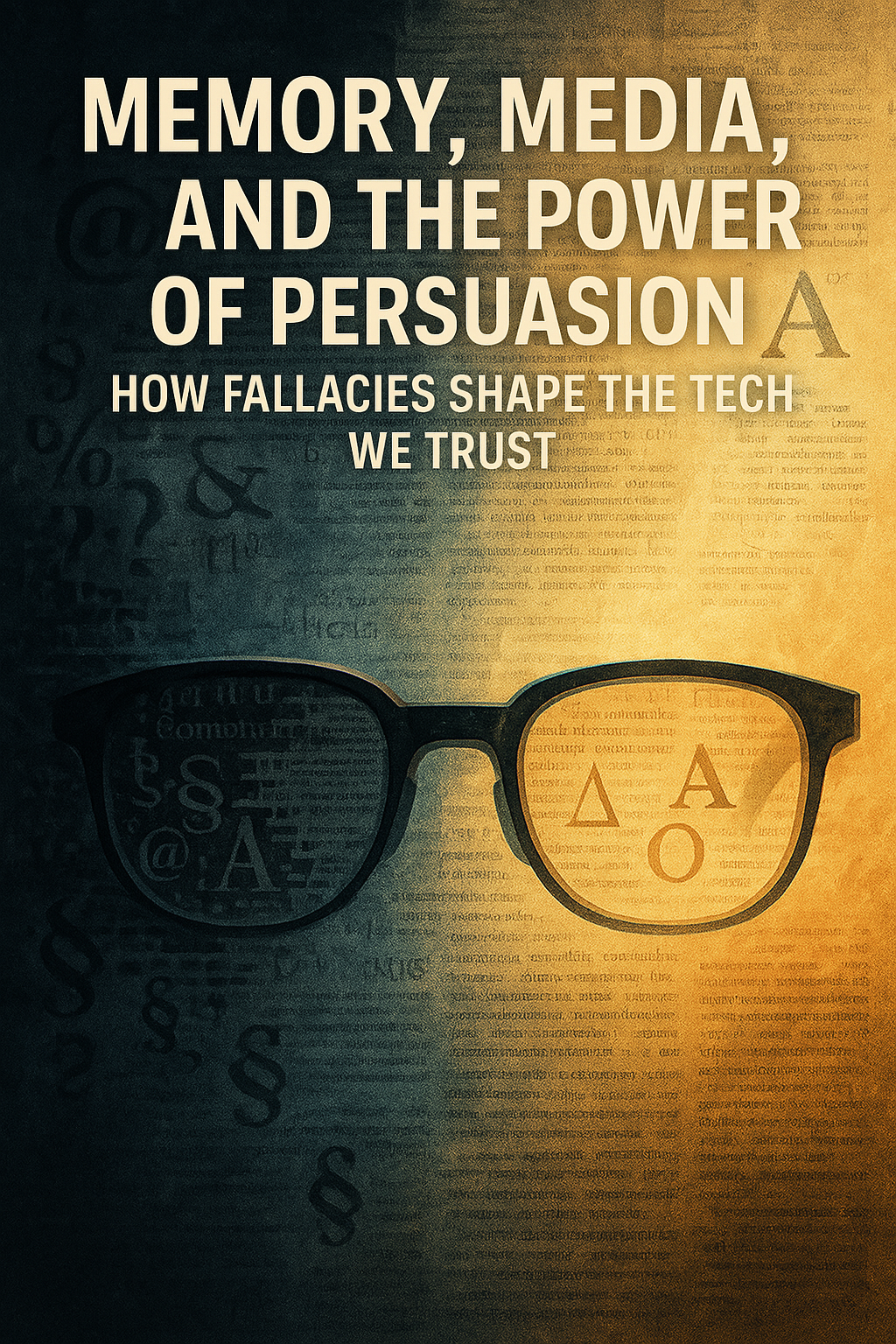Your cart is currently empty!
Memory, Media, and the Power of Persuasion

How Fallacies Shape the Tech We Trust
We live in an age where persuasion is stitched into nearly everything we see—especially in the digital media we consume. From product reviews and advertisements to opinion columns and influencer commentary, persuasive rhetoric has become part of the air we breathe. But what happens when that rhetoric is flawed? What happens when emotionally charged language or limited options are used not to inform us—but to guide our decisions?
While scrolling through CNET, I recently encountered an article that left me intrigued and skeptical. The article, “How I’m Reliving My Memories with Meta Glasses and Apple Spatial Video,” written by Scott Stein (March 25, 2024),was a glowing review of immersive memory technology. It combined personal anecdotes with futuristic vision, wrapped in the warmth of nostalgia. But underneath the surface, I noticed something worth dissecting—logical fallacies.
🎯 The Purpose: Persuading Through Experience
CNET, known for its tech-savvy audience and product-centered reviews, is a platform meant to inform consumers about the latest in technology. Stein’s article is no exception. His goal was clear: to share his personal experience with the Apple Vision Pro and Meta’s Ray-Ban smart glasses, and to subtly (or not-so-subtly) nudge readers toward integrating these technologies into their own lives.
His argument? That combining these devices could one day offer a new, enhanced way of reliving our most precious memories—like revisiting a theme park or a family vacation through the lens of spatial video.
But while his premise was emotionally engaging, I couldn’t help but notice that the path he used to get there was paved with a few rhetorical shortcuts.
⚠️ Spotting the Fallacies
Two major logical fallacies stood out in Stein’s piece:
- False Dilemma (Either-Or Fallacy)
Stein presents only two options: either the user must switch between both the Meta glasses and Apple headset to get the best experience, or the two companies should merge the technologies into a single, ideal device. This binary choice excludes other possibilities—such as waiting for competitors, using different tools, or even questioning whether such tech is necessary at all.
This false dilemma traps the reader into believing there’s no third path. In doing so, it narrows our perception of available choices—a hallmark of persuasive but flawed logic. - Hasty Generalization
Another fallacy appears in the form of overgeneralization. Stein concludes that the technology “needs improvement” and “combining the two would be the best way to relive memories,” yet he doesn’t consider the user diversity or alternative perspectives. No statistical evidence, user studies, or expert counterpoints are cited. His sweeping statements come from personal use—entertaining, but anecdotal.
By drawing broad conclusions from limited data, Stein risks persuading readers based more on personal excitement than on objective evaluation.
🧠 Classical Rhetoric at Work: Ethos, Pathos, Logos
Despite the fallacies, Stein’s rhetorical strategy is undeniably compelling—and it makes for a perfect case study in the classical appeals:
✍️ Ethos (Credibility)
Stein establishes credibility by offering a first-person narrative. His experiences at Disney World, documented through immersive technology, feel relatable and authentic. He writes not just as a tech critic, but as a parent, a traveler, a memory-keeper. This authenticity encourages readers to trust him as a peer, not just a professional.
💓 Pathos (Emotion)
Perhaps the most effective tool Stein uses is emotional appeal. He talks about “the battle for our memories,” how tech can help us relive joy and wonder, and how sound and visuals can wrap around us like comfort. These images are not accidental—they’re calculated. He taps into the universal human fear of forgetting and the longing to hold on.
📊 Logos (Logic)
To support his claims, Stein uses some factual points. He references Apple’s “Memory galleries” and Facebook’s automatic video montages as proof that tech is already pushing toward nostalgia-driven innovation. He uses current product features as logical scaffolding to build his argument for future potential.
But it’s here where we see the tension: the logic exists, but it’s selectively applied. Logos is present, but it leans heavily on speculation.
🔍 Why Fallacies Matter: A Lens for Critical Thinking
Why does any of this matter?
Because being able to identify fallacies isn’t about proving someone wrong—it’s about keeping ourselves from being passively persuaded. Recognizing fallacies allows us to pause, reflect, and ask: Am I making a decision because it’s right for me—or because it was made to feel right?
In media, marketing, and even politics, some of the most common fallacies include:
• Ad Hominem – attacking the person, not the argument.
• Straw Man – oversimplifying an opponent’s stance to refute it easily.
• Slippery Slope – implying one small step will lead to catastrophic results.
• False Dilemma – limiting choices to two when many exist.
These tactics often work because they create urgency, identity alignment, or fear. But when we understand them, we become more empowered consumers of rhetoric—not just recipients.
🔒 Final Reflection: Don’t Just Listen—Question
In a world where we’re constantly being sold to—be it a product, idea, or lifestyle—the ability to think critically is a kind of armor. Recognizing logical fallacies helps me move past the surface shine of emotional appeals and ask deeper questions: Is this true? Is it complete? Is it mine to believe?
Scott Stein’s review may have been written with sincerity, but it serves as a reminder: even well-meaning persuasion can be flawed. And as consumers of both tech and truth, we owe it to ourselves to listen not just with open ears—but with discerning minds.
📚 Works Cited
Stein, Scott. “How I’m Reliving My Memories with Meta Glasses and Apple Spatial Video.” CNET, 25 Mar. 2024. https://www.cnet.com/tech
Lunsford, Andrea, et al. Everyone’s an Author, 3rd ed., W. W. Norton & Company, 2020, pp. 411–450.
Tindale, Christopher W. Fallacies and Argument Appraisal. Cambridge University Press, 2007.
Walton, Douglas. Informal Logic: A Pragmatic Approach. Cambridge University Press, 2008.
Discover more from Poetic Bipolar Mind
Subscribe to get the latest posts sent to your email.
-

Rodriguez’s Mother’s Depressed State and Disappointment
Through narrative clues, Richard Rodriguez reveals his mother’s quiet sadness during a Christmas gathering. Surrounded by gifts yet emotionally distant, her faint smiles and contemplative silence expose the tension between outward festivity and inner disappointment. This subtle portrayal underscores the complexity of family dynamics and the emotional weight of unspoken expectations.
-

A Mother’s Desire for Her Children to Have Better Lives
A mother’s love carries both hope and burden. Richard Rodriguez’s narrative reveals the complexities of maternal desire for children’s success, the weight of expectations, and the delicate balance between guidance and individuality. This reflection invites readers to explore family dynamics, sacrifice, and the emotional ties that shape our lives.
-

Adrift in Darkness and Doom
Dave White’s Ghost Ship and Kiana Jimenez’s Night Ritual converge in a chilling meditation on death, solitude, and the unknown. The spectral vessel adrift on a darkened sea echoes the poem’s storm of fear and doom, merging art and verse into a haunting reflection of mortality and the spaces beyond.

Leave a Reply